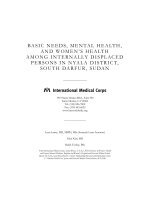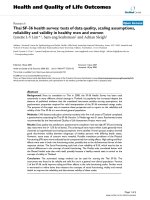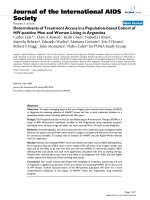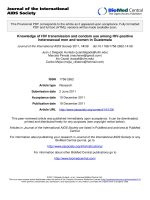Men and women’s representations in TV advertisements in vietnam a multimodal critical discourse analysis
Bạn đang xem bản rút gọn của tài liệu. Xem và tải ngay bản đầy đủ của tài liệu tại đây (982.06 KB, 70 trang )
Mã số: N14.04
Chủ nhiệm đề tài: Nguyễn Thị Thu Hà
Hà Nội 2015
ĐẠI HỌC QUỐC GIA HÀ NỘI
TRƯỜNG ĐẠI HỌC NGOẠI NGỮ
…………………………..
ĐỀ TÀI NGHIÊN CỨU KHOA HỌC CẤP TRƯỜNG
Mã số: N.14.04
HÌNH ẢNH NAM GIỚI VÀ NỮ GIỚI
TRONG QUẢNG CÁO TRÊN TRUYỀN HÌNH VIỆT NAM
TỪ GÓC ĐỘ PHÂN TÍCH DIỄN NGÔN PHÊ PHÁN
ĐA PHƯƠNG TIỆN
(Men and women’s representations in TV advertisements in Vietnam:
a multimodal critical discourse analysis)
Người thực hiện: TS. Nguyễn Thị Thu Hà
Bộ môn: Ngôn ngữ học Anh
Khoa: Ngôn ngữ và Văn hóa CNN tiếng Anh
HÀ NỘI, 7/2015
Abstract
This study investigates men and women’s representations in TV
advertisements in Vietnam from a multimodal critical discourse analysis
perspective. The data comprise of almost one hundred TV advertisements aired
on principle TV channels in Vietnam such as VTV and HTV. The framework in
use is Fairclough’s (2001), in which part of Kress and van Leeuwen’s visual
grammar (1996) is incorporated for a multimodal discourse analysis of the
advertisements. The main findings of the research include gender roles
differentiation and gender stereotypes which continue to disadvantage women
and perpetuate gender inequality. Embedding the findings into the sociopolitical context, the study argues that such representations reinforce traditional
biased assumptions about men and women despite a number of political efforts
in terms of national policies to advance gender equality in Vietnam.
i
Tóm tắt
Đây là một nghiên cứu phân tích diễn ngôn phê phán đa phương tiện
được thực hiện trên dữ liệu là 99 quảng cáo truyền hình. Khung phân tích được
sử dụng là khung do Fairclough (2001) đề xuất, lồng ghép trong đó là khung
phân tích ngữ liệu hình ảnh của Kress and van Leeuwen (1996). Nghiên cứu đã
chỉ ra rằng, thông qua việc lựa chọn sử dụng ngôn ngữ và hình ảnh có tính chất
định kiến, những quảng cáo trong dữ liệu hàm chứa các tư tưởng giới góp phần
truyền bá bất bình đẳng giới, đi ngược lại những nỗ lực về mặt phát luật của xã
hội nhằm thiết lập và duy trì sự bình đẳng về giới. Nghiên cứu cũng chỉ ra các
điển tín tìm thấy trong các quảng cáo và nhận định rằng các điển tín này gây áp
lực cho cả nam giới và nữ giới.
ii
TABLE OF CONTENTS
Abstract
i
Tóm tắt
ii
Chapter 1: Introduction
1
1.1.
Rationale ……………………………………………………………..
1
1.2.
Aims of the research and research questions ……………………….
2
1.3.
Research methods and scope of the study……………………..……
2
1.4.
Main findings of the research ……………………………………….
3
1.5.
Structure of the report ……………………………………………….
3
Chapter 2: Literature review and contextual background of the study
5
2.1. Literature review ……………………………………………………….
5
2.2. Contextual background of the study ………………………………….
7
2.3. Gender equality ………………………………………………………..
11
Chapter 3: Theoretical background and methodology
15
3.1. CDA as a theoretical approach ………………………………………....
15
3.2. Main tenets of CDA …………………………………………………….
16
3.3. CDA analytical framework …………………………………………….
21
3.4. Kress and van Leeuwen’s visual grammar …………………………….
25
Chapter 4: Findings and discussion
30
4.1. Women as homemakers …………………………………………………
30
4.2. Men and women in the caring roles ……………………………………
39
4.3. Men’s jobs are more important than women …………………………..
43
4.4. Gender stereotypes ……………………………………………………..
47
Chapter 5: Conclusion
50
5.1. Recapitulation of main findings ………………………………………..
50
5.2. Limitations and suggestions for further research ……………………..
51
References …………………………………………………………………..
52
Appendix ……………………………………………………………………
57
iii
CHAPTER 1: INTRODUCTION
1.1.
Rationale
Gender equality has been the goal of human beings for long and it has
also been the interest of not only feminists but also scholars in different domains
of social study. Feminist linguistics, in particular, is interested in identifying,
demystifying, and resisting the ways in which language is used, together with
other social practices, to reflect, create and sustain gender divisions and
inequalities in society (Talbot, 2010). According to Litosseliti (2006: 44),
discourse approaches assume that gender is culturally constituted and context
dependent, and gender needs to be studied in relation to localized contexts and
specific communities, as well as globally. However, language and gender
scholarship in general seems to reveal a heavy Anglo/American bias (Lassen &
Majstorovic, 2010); hence, there is a need for more gender and language studies
in other parts of the world in order to counter-balance this bias, moving towards
a comprehensive view of discursively constructed gender and gender
(in)equality the world over. The current study, working on media discourse and
gender equality in Vietnam, hence, serves as a stroke on the global picture of
gender and language study. Moreover, in the local context of Vietnam, gender
equality has always been an issue of concern; hence, a study on gender equality
from a discoursal perspective would contribute different insights into the
situation.
1
1.2.
Aims of the research and research questions
The study aims to show the gender ideologies underlying television
advertisements in Vietnam and how these ideologies are mediated through both
visual and linguistic means. The final goal of the research is to raise people’s
awareness of the hidden perpetuation of gender identities assumptions and
normalization, which eventually disadvantages women and reinforces gender
inequality. The study attempts to answer the following research questions:
• What are the gender ideologies underlying TV advertisements?
• How are these ideologies mediated in the discourse?
1.3.
Research methods and scope of the study
The study approaches the data of 99 TV advertisements from a critical
discourse analysis (CDA) perspective. There advertisements were videotaped
from different TV channels during October and November, 2014. The
framework used is Fairclough’s (2001) in which part of Kress and van
Leeuwen’s visual grammar (1996) is incorporated to analyze the visual features,
given that Fairclough’s framework guides the analysis of verbal elements only.
The study focuses on both the visual images and the linguistic elements in the
voiceover of advertisements, though aspects like the lengths or the time slots of
the advertisements are out of scope.
The study follows the three steps of analyzing discourse, i.e. description
of texts, interpretation of the discoursal process and explanation of the social
2
process. In the step of description of texts, the study takes into consideration
both the visual and the verbal elements. These three steps of analysis are
conducted in combination rather than one by one in a chronological order. The
findings of the study, hence, are final in the sense that they are the results of the
description of the texts at surface then the interpretation of the meanings in
connection with other discourses and the interpreter’s background knowledge
and the explanation of those interpretations in the socio-political context.
1.4.
Main findings of the research
The study finds that there exists salient gender role differentiation in
which women are bound to their home and their children much more than men.
Other than that, in the public sphere, women are represented doing less
important jobs than men. Moreover, gender stereotypes are also prevalent in
which traditional femininity and masculinity are reconstructed, which may
disadvantage women to some extent. The gender ideologies as mentioned are
both explicitly and implicitly mediated through verbal and visual elements of
the data. The study argues that such gender representation re-enforces
traditional Confucian ideas of gender hierarchy and is against some political
efforts towards gender equality.
1.5.
Structure of the report
This report has 5 main chapters. Chapter 1 introduces the research in
several aspects. It explains why the study was carried out, what the study aimed
3
to find and the methodology that was used. Chapter 1 also briefly presents the
main findings of the research. Chapter 2 reviews the global context of gender
and language studies and how the current study fits in the literature. This
chapter also sets out the contextual background of the study and makes clear the
concept of gender equality as used in this study. Chapter 3 explains the theories
that the study bases itself on and the framework which is used in the study. It
also explains in details how the framework was applied to the data to tease out
the findings. Chapter 4 discusses the findings of the research, and finally,
chapter 5 summarizes the research, acknowledges limitations and suggests ideas
for further research.
4
CHAPTER 2:
LITERATURE REVIEW AND CONTEXTUAL BACKGROUND
2.1 Literature review
Gender representation has been the focus of both media studies and
feminist linguistics for decades.
In the field of feminist linguistics, since the 1990s, much research has
focused on the discursive construction of gender, focusing on both the ways in
which language is used by men and women, and the ways in which language is
used to say things about men and women (Litosseliti, 2006). The current study
belongs to the latter category of research on language used to talk about men
and women, which investigated the gendered discourses that help shape gender
identities, gender roles or gender stereotypes. Recently, many studies have
researched the construction of (new) femininity and masculinity such as Kosetzi
& Polyzou (2009) on the construal of masculinities in a Greek men’s lifestyle
magazine, and Johnson & Young (2002) on gender identities constructed
through the voice over of an advertising program. Other studies focused on
gender stereotypes such as Milestone & Meyer (2012) investigating the
representation of women as sex objects in men’s magazines, Al-Mahadin (2003)
on gender stereotypes in cartoons, and Shifman & Lemish (2011) on gender
differences in humor. All these studies share that gender and gender identities
5
are discursively constructed, often in favour of one gender over the other,
whereby women are more often disadvantaged than men.
In the domain of media studies, gender representation has gained
attention since the 1950s (Gauntlett, 2008). However, not until ‘second wave’
feminism in the 1960s that systematic research into media images of women
flourished (Carter & Steiner, 2004). Much research was carried out, mostly
focusing on how women were portrayed in a wide array of media forms such as
television, movies, women’s and men’s magazines and advertisements. The
concern was that sexist messages of these media forms socialized people,
especially children into thinking that dichotomized and hierarchical sex-role
stereotypes were ‘natural’ and ‘normal’ (Carter & Steiner, 2004: 2). While
earlier studies in the domain saw language as the depiction of reality, which
reflected the cultural aspect of a society, later critical feminist studies emerging
during the 1970s posited that media texts never simply mirrored or reflected
‘reality’, but instead constructed hegemonic definitions of what should be
accepted as ‘reality’. Nonetheless, these studies shared the same foci with
feminist linguistic studies, concerning gender representation such as gender
identity, femininity and masculinity, gender roles or gender stereotypes.
Numerous reviews about gender representation in the media can be found in
Gauntlett (2008), Byerly & Ross (2006), Cortese (2004), Thornham (2007) and
Bentz & Mayes (1993).
6
There are two things noted from the literature of gender and language
studies. First, gender issues exist in almost all contexts; however, these issues
are different in many aspects from one context to another. This is because,
gender is a social issue which is built up in and affected by the historical,
cultural and political context of the different countries. Hence, to contribute to
the existing studies of language and gender studies, more research in diversified
cultural contexts are welcome, to add a stroke to the big picture of gender issue
the world over. Second, while this domain has flourished internationally for
decades, very few studies have been carried out in the context of Vietnam. Very
recently, Nguyen (2011) published her study on gender ideologies in print
media and Ngo & Phan (2015) researched the sexist language used in football
commentaries. These two authors did point out that sexism and gender
inequality exist in discourse in the context of Vietnam, however with only two
studies, gender issues in relation to language in Vietnam cannot be
comprehensively exploited. More efforts are needed to dwell into this topic for
the sake of social equity in Vietnam and for the international academic literature
of language and gender. The current study is an attempt to answer the raised
necessity.
2.2 Contextual background of the study
As said, gender issue roots from the historical, socio-political context;
hence, when the issue is studied, especially from a CDA perspective, an
7
understanding of contextual background should be required. There are some
main points to note concerning gender issue in Vietnam as follows.
First, Vietnamese women were not originally oppressed. The historical
fact of constant wars in Vietnam has aroused and nurtured a centuries - old
tradition of heroism and nationalism among the Vietnamese people and women
were not exceptions. During the Chinese conquest (207 B.C. - 39 A.D.), Trung
Trac, Trung Nhi and Lady Trieu were prominent examples of combative
nationalists who rose up in arms against Chinese rulers. During the two
resistance wars against France and the U.S., there were no less examples of
combative nationalist females, who were conferred with ‘heroines of armed
forces’ by the state, such as heroine Vo Thi Sau and General Nguyen Thi Dinh,
(Le, 2009; Tran, 2009). For all their contribution to the national resistance wars,
the state conferred all the Vietnamese women with 10 golden words “Phụ nữ
Việt Nam bất khuất, trung hậu, đảm đang” (The Vietnamese women:
undaunted, faithful and skillful). This explains why Vietnamese women have
been glorified especially as martyrs throughout history although they were at
times devalued by Confucian ideas. In the contemporary Vietnam, women
continued to be glorified especially on certain occasions such as International
Women’s day (Nguyen, 2011).
Second, the Confucian influence was a cause to the decline in Vietnamese
women’s status. As history goes, Confucian ideals started to infiltrate into the
8
society in the fifth century; however, not until the fifteenth century had
Confucian impact come to its peak to become one of the three religions in
Vietnam besides Buddhism and Daoism. Central to Confucian doctrine was that
men are superior and women inferior. Confucian doctrine clearly supported a
patriarchal social order, putting women in a lower social rank compared to men.
Although Confucian ideals of gender were more or less eroded when Vietnam
came into contact with Western people from France in early twentieth century
and they were later legally eradicated by the first constitution of Vietnam
granting equal rights for both genders, these ideals seem not to be washed off
from people’s mind. And in this 21st century, the Confucian ideals concerning
gender even seem to be restored in the Vietnamese society. (Le, 1992; Bui,
1996; Le, 1996). Later in this research report, I will also discuss this restoration
from my data analysis.
Third, there have been no explicit feminist movements in Vietnam and
feminism has been an unpopular topic. This lack of feminist movements can be
due to continuous resistance wars and it was those repetitive, prolonged wars
and poverty have together overshadowed gender issues (Duong, 2001). From a
Western point of view, Barry (1996 : 14) finds that the isolation of Vietnam
until the last few years has not made it possible for women in Vietnam to
develop autonomous women’s movements that have characterized an important
element of feminist change in many other countries in the world. Vietnamese
9
women’s movements are not feminist, and have been closely attached to
nationalism. These movements were not feminist in the sense that the cause
underlying them was not primarily for women’s own rights and benefits but for
the call of the nation or more neutrally, the call of political leadership in time of
political instability. One clear example is the foundation the Vietnamese
Women’s Union (VWU) in 1930 with the highlighted task of mobilizing women
nationwide to take part in the anti-feudalism and anti-imperialism movements
led by the Indochinese Communist Party, which constantly emphasized the
importance of women’s participation in politics in order to strengthen the
revolutionary movement (Hannam, 2007: 91). The gender ideology underlying
this was Marxist in seeing the sameness between men and women and while
there might have been oppression by men on women, they were ‘ultimately
oppressed by capitalism and hence the interest of men and women are not
crucially different’ (Beasley, 1999).
Fourth, Vietnam is an advanced country in terms of gender equality
promoting policies. Although Vietnamese women gained suffrage in 1945,
much later than those in many western countries, most other political rights
were granted to them right after the suffrage without any feminist struggles. In
the country’s constitution, they have been equal to men in all respects since
1946 while internationally it is well documented that the Women’s Liberation
Movement in Western countries started in the 1960s and 1970s (Hannam,
10
2007:7). Apart from the constitution, gender issues have been reflected in the
laws on marriage and family first composed in 1959. More recently, Vietnam
passed the laws on gender equality in 2006, the aim of which was to eradicate
gender discrimination and to build gender equality in all aspects of social life
and in the family. Alongside with Laws on gender equality, Laws on prevention
of domestic violence became effective in 2008, prescribing how to educate
people about, prevent people from and punish people for crimes which had been
protected by the patriarchal society for long. Additionally, promoting gender
equality is the responsibility of different governmental institutions such as the
National Committee for the Advancement of Women in Vietnam and the
Vietnam Women’s Union. In liberal terms, Vietnamese women have gained the
rights that women elsewhere in the world have been struggling for for centuries.
In this context, the study aims to look at the gender ideologies underlying
advertisement discourse and to see if those ideologies reconstruct or challenge
any existing gender ideologies in the society.
2.3. Gender equality
In this study, gender equality is limited to the equality between women and
men in the society, although a post-structuralist approach may also concern the
equality between different groups of men and that between different groups of
women. Theoretically, there has been no consensus among feminists on what
gender equality is, and different feminisms have posited equal gender relations
11
differently. Beasley (1999) summarized some of the major differences in feminist
views on gender equality as follow.
Liberal feminism, on the one hand, presumes the sameness between men
and women as both men and women possess fundamentally sexually
undifferentiated human nature. Since women are much the same as men, women
should be able to do what men do. In liberal feminist thoughts, there is a focus on
the public sphere, on legal, political and institutional struggles for the rights of
individuals to compete in the public marketplace. Radical feminism, on the other
hand, stresses the difference between men and women, and at the same time
asserts the sameness among women regardless of class, race, age, ethnic group or
nationality. It gives a positive value to womanhood rather than supporting a
notion of assimilating women into arenas of activity associated with men. In
other words, women and men are seen as different but complementary and they
should be equally valuable. Such an agenda encourages some degree of
‘separatism’ from men, and men as a group are the ‘main enemy’ of women. The
third major feminist tradition is Marxist/socialist feminism, which tends to be
oriented towards the public sphere like liberal feminism. Marxist/ socialist
feminism also stresses the underlying sameness between men and women and
proposes that while women seem to be oppressed by men around them, like men,
women are ultimately oppressed by capitalism, and hence the interests of men
and women are not crucially different (Beasley, 1999:62). It is important to note
12
that different feminist views may develop from or challenge the other feminist
views on gender equality.
More recently, feminist writings have been influenced by poststructuralist
thinking that stresses plurality rather than unity and, in particular, rejects
conceptions of women or men as a homogeneous category. Poststructuralist
feminists emphasize the differences amongst women and amongst men rather
than differences between women and men. They argue that universalism
marginalizes what is seen as dissimilar, thus bringing into play normalization,
which declares dissimilarity abnormal and attaches a negative judgment to nonconformity (Beasley, 1999:81). They see gender as socially/ discursively
constructed; and hence, gender identity is in flux, unstable and can be changed.
While sex is generally seen as dichotomous, gender is a continuum and should
not be mapped onto sex. That means only some women and some men exist at
the two extremes of femininity and masculinity respectively, producing gender
stereotypes and the rest can be found somewhere on the gender continuum, and
gender identity is also context dependent (Baker, 2008:63). Poststructuralist
feminists are against the mapping of gender onto sex, which is constituted by
social practices reflecting norms and taboos.
In this study, I draw on a poststructuralist view of gender equality. Since
there are differences amongst women as well as differences between women and
men, the latter should not be stressed, resulting in gendered tasks and gendered
13
stereotypical assumptions on men and women. There are admittedly biological
sex differences between women and men; however, these differences do not
necessarily entail differences in their socially expected roles. Sex differences
should be treated just like other different biological traits such as height or eye
color. Concerning the roles of women and men in the society, gender equality in
this study means equitable division of responsibilities between women and men
in both the public and domestic spheres. Further, women and men should be
given equal choices concerning their social and family lives. The perpetuation of
restricted roles for men and/or women, hence, is the dissemination of gender
inequality.
14
CHAPTER 3:
THEORETICAL BACKGROUND AND METHODOLOGY
3.1 CDA as a theoretical approach
Current research in the field of language and gender in general, and
feminist linguistics in particular, has been carried out using various approaches
and methods such as sociolinguistics and ethnography, corpus linguistics,
conversation analysis (CA), discursive psychology, CDA, and feminist poststructuralist discourse analysis (Harrington et al, 2008). The current study has
chosen CDA as its theoretical approach for CDA starts with social issues and it
‘aims to show non-obvious ways in which language is involved in social
relations of power and domination’ (Fairclough, 2001: 229). CDA sees
language as ‘a form of social practice’, which is socially determined and
determinative at the same time (Fairclough, 2001: 22). CDA is committed to
examining the way language contributes to social reproduction or social change;
hence, CDA is theoretically well placed to identify gendered discourses.
According to Talbot (2010: 118), looking at language critically is a way of
denaturalizing it, so CDA is useful for feminist linguistic research. Lazar (2005)
also proves the inevitable marriage between CDA and feminist linguistics in her
edited volume of studies taking feminist CDA as a perspective to deal with
gender ideologies in discourse. (Wodak, 1997 as quoted in Sunderland, 2006:
15
59) also asserts that ‘many proposals and basic assumptions of feminist
linguistics relate to and overlap with principles of critical discourse analysis’.
3.2. Main tenets of CDA
CDA emerged in the 1970s, reflecting a turn in the interest of linguistic
research from the purely structural dimension to the functional aspect of
language as it relates to the social. CDA studies language use in its socio political context and regards ‘language as social practice’ (Fairclough and
Wodak, 1997). CDA pays particular attention to the relation between language
and power, aiming to unearth the ideologies underlying discourse.
Phillips and Jorgensen (2002) summarize five CDA tenets and principles
as follow.
First, situating language use in social networks, CDA perceives
discourse, or discursive practice, as social practice. It is undeniable that
language is a social phenomenon and is part of society, not somehow external to
it (Fairclough, 2001). Linguistic phenomena are social phenomena of a special
sort, and social phenomena are (in part) linguistic phenomena. According to
Eckert and Mc Connell-Ginet (2003: 43), the term ‘social practice’ refers to
human activity when emphasizing the conventional aspect of activity and its
relation to social structure. While social structure constrains practice, it does not
determine it. It is important to highlight what discourse refers to as this term is
often ‘left undefined, vague or confusing’ (Mills, 1997; Wodak, 1997). In one
16
sense, discourse refers to the communicative process in which language in the
form of texts is produced and interpreted in a social communicative setting.
Discourse encompasses not only spoken and written linguistic texts but also
other forms of communication such as visual or audio-visual modes. A current
view of discourse sees that discourse in most cases is multi-modal (Kress and
van Leeuwen, 1996); hence, a comprehensive analysis of discourse must
include forms of communication other than language. In a more poststructuralist sense, discourse is a way of representing and interpreting social
realities. Discourses exist in relation to other discourses and these discourses
can be supporting as well as competing or conflicting. In this study, the term
discourse is used in both senses: as language in use and as ways of representing
and interpreting social realities. As Phillips and Jorgensen (2002) put it, the aim
of CDA is to shed light on the discursive dimension of social and cultural
phenomena and processes of change.
Second, discourse is both socially constituted and constitutive. As
mentioned in the first principle, discourse is a social practice; consequently, it
complies with social conventions in reflecting social reality. In this sense,
discourse is conditioned by the social in two dimensions. First, discourse
signifies the extra-discursive, conditioned by other already existing discourses.
Second, how discourse reflects reality is conditioned by socially acceptable
ways of doing it. In a nutshell, discourse is socially constituted in both the what
17
and the how dimensions. The relation between discourse and the social,
however, is not a one way process but a dialectical one (Fairclough, 2001).
Discourse is constitutive at the same time because discourse also contributes to
the shaping and reshaping of social structures. In other words, discourse has
effects upon social structures and contributes to the achievement of social
continuity or social change. In a sense, social structures are partly a product of
discourse. Foucault (1972) emphasizes the potential constitutiveness of
discourse by defining it as ‘the practices that systematically form the objects of
which they speak’. However, CDA is less post-structuralist in that it does not
negate the material that exists independently from discourse as most poststructuralists maintain. Discourse is not omnipotent, and is conditioned by
social reality or other discourses. As Chouliaraki and Fairclough (1999: 6) put
it, CDA recognizes the social import of discourse without reducing social life to
discourse.
Third, discourse should be analyzed within its social context. This
principle derives from the first and the second tenets, defining discourse as
social practice and conditioned by social structures. In other words, discourse is
historical and can only be understood with reference to its context or existing
discourses. Hence, in Fairclough’s model (2001), text analysis is not carried out
separately but within discoursal interaction and social context. Analyzing
discourse means not just analyzing texts, nor analyzing processes of production
18
and interpretation, but analyzing the relationship between texts, processes, and
their social conditions. Social conditions include both the immediate conditions
of the situational context and the conditions of institutional and social structures
on a higher level (Fairclough, 2001). Beyond context, which refers to the
extralinguistic factors such as culture, political condition and ideology, CDA
also introduces the notion of intertextuality and interdiscursivity, which
highlight the importance of seeing texts in relation to other existing texts.
Different from all other methods, CDA takes into consideration a wide range of
factors that influence the production and consumption of texts.
Fourth, discourse functions ideologically. At the heart of CDA is the
claim that underlying discourse is ideology or that ideology is mediated through
language use. (Fairclough, 2001, 1995). At this point, CDA shares with the
Marxist tradition the view that discourse can be a tool to disseminate and to
suppress ideology. Discourse, hence, reflects the interests of certain social
groups, based on race, gender, age and so on. This principle is not just
applicable to political or mass media discourse, which is believed to have
massive influence on the public but also true with individual use of language.
Since language is a resource with which people constantly have to make choices
in communication, they may be unaware of the fact that their beliefs and
viewpoints are embedded in their linguistic selections. In other words, our
language is far from neutral. According to Coates (1998: 302), there is no
19
neutral discourse; whenever we speak, we have to choose between different
systems of meaning and different sets of values. Language embodies our
cultural and social values; hence, when we speak, we do not just say words, we
speak our culture (Goddard & Patterson, 2000: 67). CDA practitioners,
however, do not ask whether certain ideologies are deliberately or
subconsciously embedded; rather, they are interested in finding out what the
underlying ideologies are. If certain ideologies disadvantage a particular social
group, then the uncovering of these ideologies can raise people’s awareness,
which is believed by CDA practitioners to be the first step towards
emancipation.
Fifth, CDA is research with a stance. Different from scientific research
especially one in the natural science domain which places importance on
objectivity, CDA does not claim itself as politically neutral and is always
explicit about its own position and commitment. Critical analysts must take a
clear political stance from the beginning, aiming to uncover the discursive
practice that maintains the unequal power relations. CDA is committed to
radical social change for fairness and equality. CDA, hence, takes sides with the
oppressed and less powerful in discourse. For instance, feminists often use CDA
to challenge discourses in which women are disadvantaged and where gender
inequality exists. However, this does not mean that CDA is a biased
interpretation or a political commentary where the authors interpret meaning
20









